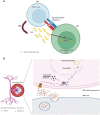Non-cytotoxic functions of CD8 T cells: "repentance of a serial killer"
- PMID: 36172358
- PMCID: PMC9511018
- DOI: 10.3389/fimmu.2022.1001129
Non-cytotoxic functions of CD8 T cells: "repentance of a serial killer"
Abstract
Cytotoxic CD8 T cells (CTLs) are classically described as the "serial killers" of the immune system, where they play a pivotal role in protective immunity against a wide spectrum of pathogens and tumors. Ironically, they are critical drivers of transplant rejection and autoimmune diseases, a scenario very similar to the famous novel "The strange case of Dr. Jekyll and Mr. Hyde". Until recently, it has not been well-appreciated whether CTLs can also acquire non-cytotoxic functions in health and disease. Several investigations into this question revealed their non-cytotoxic functions through interactions with various immune and non-immune cells. In this review, we will establish a new classification for CD8 T cell functions including cytotoxic and non-cytotoxic. Further, we will discuss this novel concept and speculate on how these functions could contribute to homeostasis of the immune system as well as immunological responses in transplantation, cancer, and autoimmune diseases.
Keywords: CD8 T cells (CTLs); cross-talk; direct-; indirect-; non-cytotoxic.
Copyright © 2022 Al Moussawy and Abdelsamed.
Conflict of interest statement
The authors declare that the research was conducted in the absence of any commercial or financial relationships that could be construed as a potential conflict of interest.
Figures




Similar articles
-
Professional killers: The role of extracellular vesicles in the reciprocal interactions between natural killer, CD8+ cytotoxic T-cells and tumour cells.J Extracell Vesicles. 2021 Apr;10(6):e12075. doi: 10.1002/jev2.12075. Epub 2021 Apr 1. J Extracell Vesicles. 2021. PMID: 33815694 Free PMC article. Review.
-
CD8+ cytotoxic T lymphocytes in cancer immunotherapy: A review.J Cell Physiol. 2019 Jun;234(6):8509-8521. doi: 10.1002/jcp.27782. Epub 2018 Nov 22. J Cell Physiol. 2019. PMID: 30520029 Review.
-
Cytotoxic T Lymphocytes (CTLs) and Kidney Transplantation: An Overview.Methods Mol Biol. 2021;2325:203-213. doi: 10.1007/978-1-0716-1507-2_14. Methods Mol Biol. 2021. PMID: 34053060 Review.
-
Clinical-Grade Human Multipotent Adult Progenitor Cells Block CD8+ Cytotoxic T Lymphocytes.Stem Cells Transl Med. 2016 Dec;5(12):1607-1619. doi: 10.5966/sctm.2016-0030. Epub 2016 Jul 27. Stem Cells Transl Med. 2016. PMID: 27465071 Free PMC article.
-
Arming a killer: mitochondrial regulation of CD8+ T cell cytotoxicity.Trends Cell Biol. 2023 Feb;33(2):138-147. doi: 10.1016/j.tcb.2022.05.007. Epub 2022 Jun 23. Trends Cell Biol. 2023. PMID: 35753961 Review.
Cited by
-
CD8 T cells are dispensable for experimental autoimmune prostatitis induction and chronic pelvic pain development.Front Immunol. 2024 May 14;15:1387142. doi: 10.3389/fimmu.2024.1387142. eCollection 2024. Front Immunol. 2024. PMID: 38807587 Free PMC article.
-
CTLs heterogeneity and plasticity: implications for cancer immunotherapy.Mol Cancer. 2024 Mar 21;23(1):58. doi: 10.1186/s12943-024-01972-6. Mol Cancer. 2024. PMID: 38515134 Free PMC article. Review.
-
CD8+ Lymphocytes from Healthy Blood Donors Secrete Antiviral Levels of Interferon-Alpha.Viruses. 2023 Mar 30;15(4):894. doi: 10.3390/v15040894. Viruses. 2023. PMID: 37112874 Free PMC article.
-
Recent Findings on Therapeutic Cancer Vaccines: An Updated Review.Biomolecules. 2024 Apr 21;14(4):503. doi: 10.3390/biom14040503. Biomolecules. 2024. PMID: 38672519 Free PMC article. Review.
References
-
- Govaerts A. Cellular antibodies in kidney homotransplantation. J Immunol (1960) 85:516–22. Available at: https://www.jimmunol.org/content/85/5/516 - PubMed
Publication types
MeSH terms
LinkOut - more resources
Full Text Sources
Medical
Research Materials

